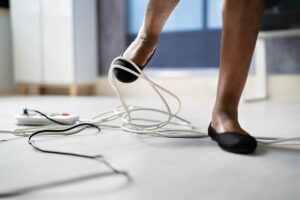From choosing a realtor and touring potential homes, to applying for a mortgage and signing many documents, buying a home can be a nerve-racking experience whether you are looking to buy your first or tenth home. The Safe Electricity program wants to help make the process a little less stressful and is sharing tips for home buyers.
“When people look at buying a home, they oftentimes will list their needs and wants,” says Mike Ashenfelter, Safe Electricity Advisory Board member. “While looking at the physical features, number of bedrooms, and size of a potential home to fit your needs, it is also important to take note of the safety of the home.”
The large majority of homes sold every year have already been lived in, and have the natural wear and tear of age and use. In 2015 alone, the National Association of Realtors reports approximately 5,250,000 existing homes were sold, while the U.S. Census Bureau noted 510,000 newly constructed homes were sold.
Safe Electricity provides the following checklist to help as you tour potential homes to evaluate potential hazards.
- Outlets – Note the location and number of outlets in each room. If the outlets only have two prongs and are missing the third hole for the grounding pin, the home is not grounded. You will want to consider having the electrical system updated.
- Ground fault circuit interrupters (GFCIs) – GFCIs provide protection against shock from an electrified appliance in contact with water. It is important that GFCI outlets are installed in areas where water and electricity may meet. This would include bathrooms, kitchens, garages, basements, outdoors, etc. If GFCIs are not in the home, you will want to plan on having them installed for your safety.
- Lighting – Flip on lights and listen for any popping or sizzling sounds. If there are, there may be an electrical issue.
- Appliances – Check the age and status of appliances that will come with the house. This could include: furnace, HVAC, water heater, refrigerator, oven, etc. Will these appliances need to be replaced in the near future? Are they working properly?
- Faucets – Turn on faucets to make sure they are running and draining properly, and that there are no leaks.
- Sump pump/drainage – If the home has a basement, check for a sump pump or proper drainage. A basement susceptible to flooding can be dangerous and costly.
- Insulation – Check to see if the home is properly insulated. Insulated areas should include attics, ducts, crawlspace walls, and floors or walls that are adjacent to unheated spaces.
- Roof – Note the condition and age of the roof, and the material it is made of. An old roof may leak and cause damage to the structure of the home.
- Detectors – Check if smoke and carbon monoxide detectors are in the home.
“Although it is important to be aware of potential hazards in a home, as a buyer you likely won’t be able to check every detail of the home yourself. It’s best to hire a home inspector to take a look at your potential new home before signing the paperwork for the keys,” Ashenfelter advises.A home inspector will examine all parts of the home, and will provide you with a full report. Anything that is wrong with the house, you can choose to negotiate with the seller to fix the issues, fix the problems yourself after purchase, or back out of the deal.
For more information on home electrical safety, visit SafeElectricity.org.









